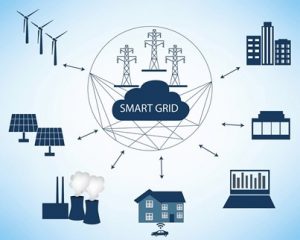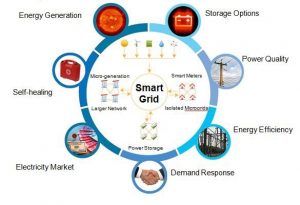
Smart Grids. A More Sustainable, Smarter, and Efficient Way of Using Energy
26 of December of 2018
Smart grids have changed the business model of the electricity industry and the relationship between its players, from energy companies to the final consumer. They are the result of needing to transition from a centralized network to a more derived one, capable of managing the increasing complexity of supplying electricity in times of the digital revolution.
But, what is a smart grid?

Essentially, smart grids are a system introduced to overcome the weakness of conventional electrical grids by using smart net meters. They allow one to monitor, analyze, control, and communicate within the energy supply chain to help improve efficiency, reduce consumption and costs, and maximize the transparency and reliability of the system.
In other words, by leveraging automation tools and other cutting-edge technologies, smart grids give a sound response to the volatile demand for electricity in the 21st century.
Its name combines the term “grid”, referred to a network of transmission lines, substations, transformers and facilities that deliver electricity from the power plant to your home or business; and “smart”, related to the implementation of digital technology in these traditional networks.
Their guiding principle is that energy is often lost because it must be consumed at the moment of its generation, and that a smarter system could help us transition to far more efficient grids.
You can better understand the concept behind these grids in the following video:
And how does a smart grid work?
A smart grid is an installation in which consumption levels are always visible—not only through the electricity bill, but because it is possible to monitor and measure the electrical behavior of each of the appliances connected to the infrastructure.
To achieve this, a smart grid incorporates automated computer systems capable of automatically responding to fluctuations in energy production. Thanks to this groundbreaking approach, both the end user and the distributor have more information, which paves the way for a more responsible use of the energy throughout the cycle: all the way from the generation plants to our households and offices.
Among the capabilities of these smart grids, we could highlight that they repair themselves, encourage consumer participation in grid operations, ensure a reliable and premium-quality supply even in the event of leakages, allow the electricity markets to grow, and can be operated more efficiently.
Some of its key features include:
- Load handling. The load of any given power grid is never stable and varies over time, but in the event of a heavy load, smart grid systems can advise consumers to temporarily minimize energy consumption.
- Demand response support. Smart grids allow users to reduce their electricity bills by advising them to use low-priority electronic devices when rates are lower.
- Decentralization of power generation. Thanks to their decentralization, smart grids allow individual users to generate onsite power by employing any appropriate methods at their discretion.
Finally, what are the benefits of a smart grid?
While summarizing some of its features, we’ve already touched upon several benefits of smart grids, but it is also worth highlighting:
- The potential energy savings through reduced consumption, because users of smart grids are informed of their consumption and contracted power at all times, and can adjust those parameters to meet their real needs.
- Better customer services, more accurate energy bills, and easier fraud detection.
- Increased competition in the energy industry, thanks to lower entry barriers.
- A more levelled demand curve, and therefore less peaks.
- A better integration of customer-owned power generation systems.
- A reduction of carbon emissions through the integration of renewable energy sources.
- And improved security.

Some smart grids initiatives sorted by regions
Many governments around the world have been encouraging the use of smart grids to help prevent global warming, become more resilient in case of emergency or increase their energetic autonomy.
For example, the EU introduced a 30-year strategic energy technology plan in 2006 for the development of a smart electricity system in order to meet its 2020 targets—which includes increasing energy efficiency, boosting its share of renewable sources and reducing its greenhouse gas emissions by 20%, among others.
In the US, 45 states and four territories already have mandatory net metering rules available for solar and wind renewable sources.
Among Latin American countries, the two key markets for smart grids have been Mexico and Brazil so far. Additionally, Argentina, Chile, and Peru are likely to veer towards smart grid systems as well, particularly to feed more renewable energy into their grids.
As for Asia, India has a target of installing 130 smart meters by 2021 under a Smart City initiative, and in 2013, China overtook the US as the world’s largest smart grid market.
So, it seems that Smart grids has arrived to stay and revolutionize the way we consume energy and contribute to create a more sustainable world. What will be next?





There are no comments yet